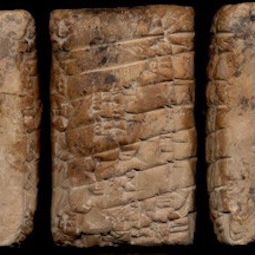The "Town Site" or "House Ruins" (Mound T)
The phrase "town site" or "house ruins" refers to the remains of houses found close to the ziggurat of Zababa (Mound T). Tablets sold on the antiquities market before 1912 are believed to have come from this area. When Genouillac first came to the site in 1912, he chose to excavate where he could still see the pits made by previous Iraqi explorers (Genouillac 1924-25: I, 19).
 [/kish/images/town-ruins-P142806-large.jpg]
[/kish/images/town-ruins-P142806-large.jpg]1. A small cuneiform tablet from Locus 3 in the Town Ruins of Tell Uhaimir. It contains 13 lines from an Old Babylonian vocabulary exercise now known as Ura 1-2, listing Sumerian words for temple offerings, personal gifts, and interest on loans. Source: Ashmolean 1924.519 on CDLI. [https://cdli.earth/artifacts/142806]
When Mackay began excavating at Tell Uhaimir for the OFME in 1923, he explored this same area. Here, his team unearthed over 35 rooms, which looked like individual houses or self-contained buildings, and found many cuneiform tablets and a bone object which may have been a stylus (Moorey 1978: 29). The cuneiform texts include administrative documents (mostly about rations), letters, contracts but also school exercises, and literary fragments.
- Browse the Old Babylonian texts from the Town Site in the Oracc Kish corpus [/kish/house-ruins]
Despite the lack of plans and archaeological reports, Naoko Ohgama and Eleanor Robson (2010: 212–29) were able to identify a group of tablets produced by young Babylonian students who lived in the Town Site in the 18th century BC. Their exercises included lists of words and names, elementary mathematics, and model letters. But there were no dedicated school buildings at Kish, or anywhere in the cuneiform world. Instead, small groups of young learners were probably home-schooled by parents or part-time tutors (Robson 2025).
15 Sep 2025
Nadia Aït Saïd-Ghanem & Eleanor Robson
Nadia Aït Saïd-Ghanem & Eleanor Robson, 'The "Town Site" or "House Ruins" (Mound T)', The Forgotten City of Kish • مدينة كيش المنسية, The Kish Project, 2025 [http://oracc.org/MoundsofKish/TellUhaimir/TownSite/]